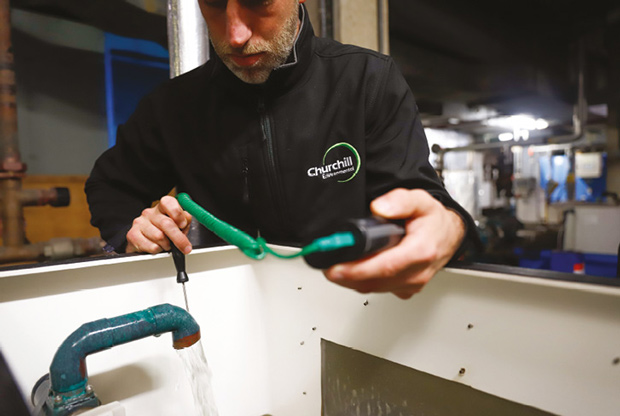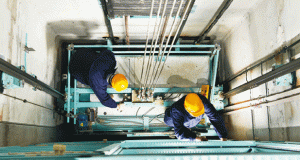 John Riley, Managing Director at Churchill Environmental Services, details how water hygiene compliance demands specialist expertise, where a generic technician may lack the necessary experience
John Riley, Managing Director at Churchill Environmental Services, details how water hygiene compliance demands specialist expertise, where a generic technician may lack the necessary experience
Total Facilities Management (TFM) models have gained appeal among customers seeking streamlined services under a single provider to reduce complexity and cost.
However, when it comes to compliance-critical areas like water hygiene, the pursuit of simplicity could carry serious consequences. Water hygiene operations are essential for building safety, yet without specialist training and experience, technicians may lack the in-depth understanding of water systems, microbiology and chemistry. If that knowledge is lacking, it can be the difference between effectively implementing controls and risking contamination or even an outbreak.
BRIDGING THE KNOWLEDGE GAP
The difference between effective control implementation and risking contamination often lies in the depth of specialist knowledge. Water hygiene demands a dedicated, safety-first, systematic approach rather than a siloed one. This specialised work must feed into live documentation of assets and infrastructure to maintain comprehensive oversight.
Cost-saving aspects of TFM may create gaps in the interconnected systems of reporting that oversee a building’s overall health, especially with multiple robust compliance systems at play in this field. Streamlined operations must not compromise the rigorous standards required for water safety compliance.
For example, teams need to adhere to the monitoring and inspection regime and British Standards, including BS 7592 Sampling for legionella bacteria, BS 8580-1 Legionella risk assessments and Control of Substances Hazardous to Health Regulations. They must also operate under primary safety regulators like the Health and Safety Executive and the Care Quality Commission.
Understanding these compliance needs requires an in-depth focus to conduct assessments and report them back to estates teams effectively. This includes treatment services through non-intrusive filtration, dosing and control of biocides and anti-corrosion products, and system flushing procedures.
BEYOND THE SURFACE ASSESSMENTS
Assessments are inherently complex. Meeting statutory and legislative requirements is one element, but developing schematic diagrams and updated asset registers to oversee and control any risks requires routine supervision and supportive programmes, like emergency escalation plans in case of a significant risk.
For example, legionella risk detection demands adherence to the Legionella Control Association (LCA) service standards, requiring comprehensive management arrangements and monitoring records. Teams must inspect building water systems installations to establish exposure risks to legionella bacteria with meticulous attention to detail.
LCA registered companies and certified members of the LCA need to follow this guidance. Organisations like ours also provide legionella training to other responsible persons, like landlords, employers and premises controllers of organisations, to ensure they can confidently manage legionella and water hygiene issues. This dual approach of specialist compliance and knowledge transfer ensures a broader understanding while maintaining expert oversight where it matters most.
SYSTEM INTEGRATION IS IMPERATIVE
The critical question arises: what happens once a risk assessment takes place? In siloed operations, records kept solely on sheets may fail to feed information back into overall building operations. Risk assessments and system asset surveys should construct a 360-degree view of building water systems, but this only occurs when robust integration systems are in place.
Providers need comprehensive compliance management tools that customers can access directly. However, a patchwork system of suppliers under management doesn’t automatically ensure connectivity. An assessor might provide thorough building assessments and capture data properly, but without feedback mechanisms to other team members and building management, visibility remains compromised.
True interconnectivity requires conducting comprehensive risk assessments that capture asset condition, location and service history. This information must integrate into real-time asset data within connected reporting systems, enabling effective management of monthly maintenance, removal of at-risk assets, and updates to live risk documentation.
A legionella risk assessment, for example, must not sit on a shelf until review; the results should feed into a live system. Without it, ongoing remedial works, including system fixes, upgrades and safety measures taken, will not consider the risk assessment outcome. The ramifications may involve fines, prosecution, and even fatalities.
If organisations lack a scheme and escalation procedure to prevent and control legionella risks, they may fail to measure water temperatures, ensure safe levels are maintained, regularly test for legionella, and ultimately risk individuals contracting legionnaires’ disease. Assessments like these need to be constantly considered within the wider ecosystem of compliance, rather than left to gather dust.
Systems designed for compliance management ensure that critical information flows seamlessly between assessment teams, leaving no stone unturned, so building management and ongoing operational oversight feed into one another.





